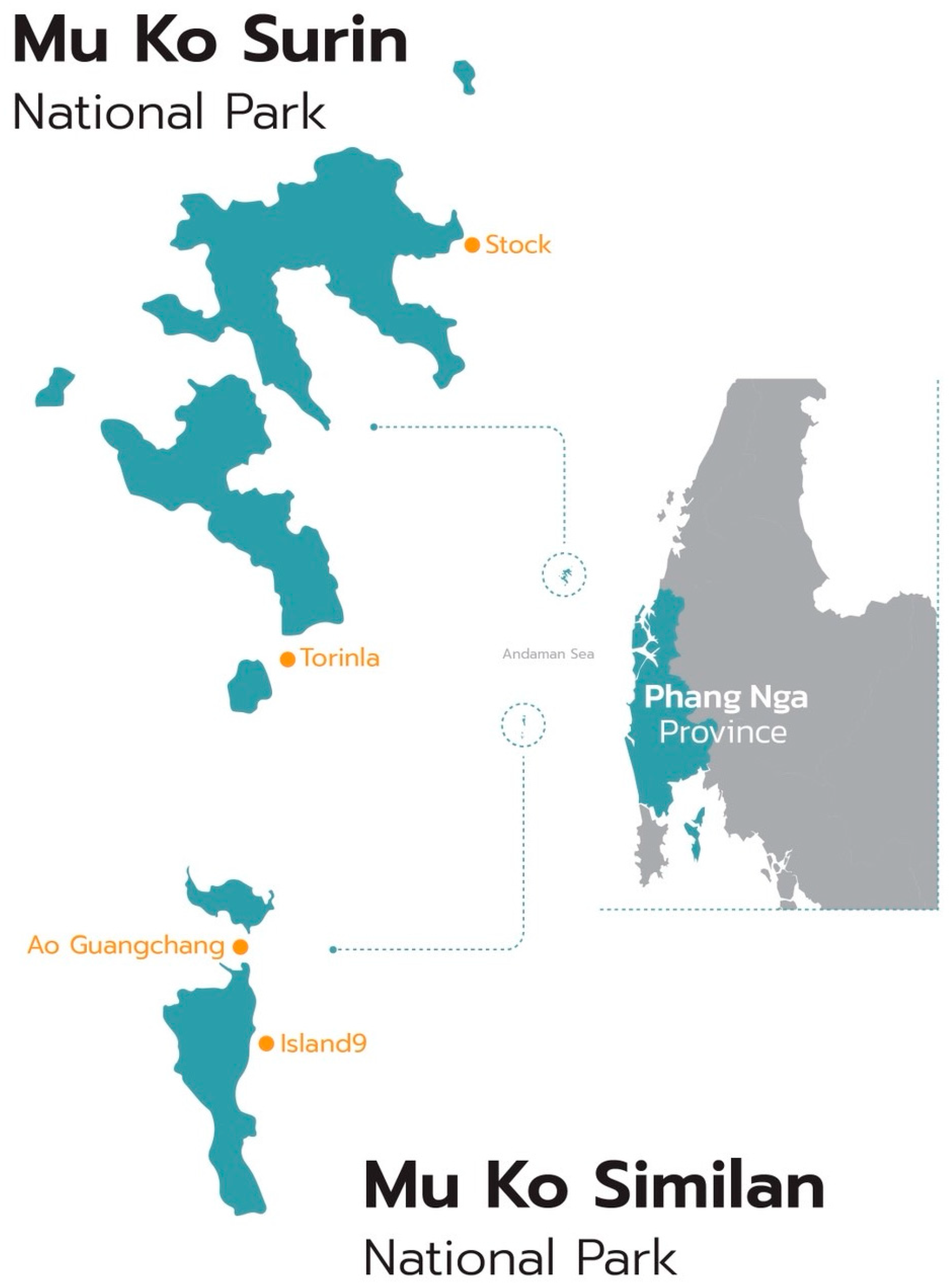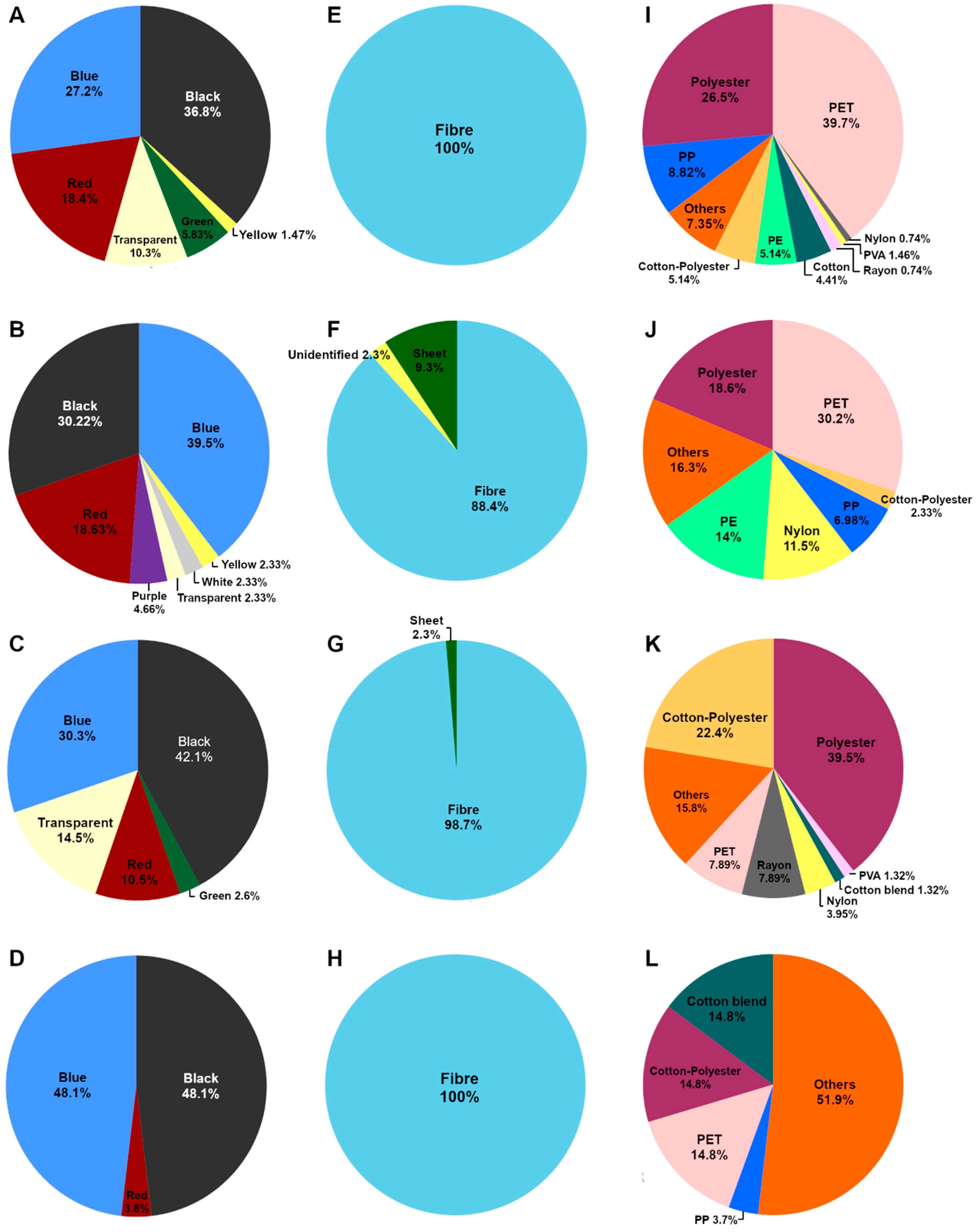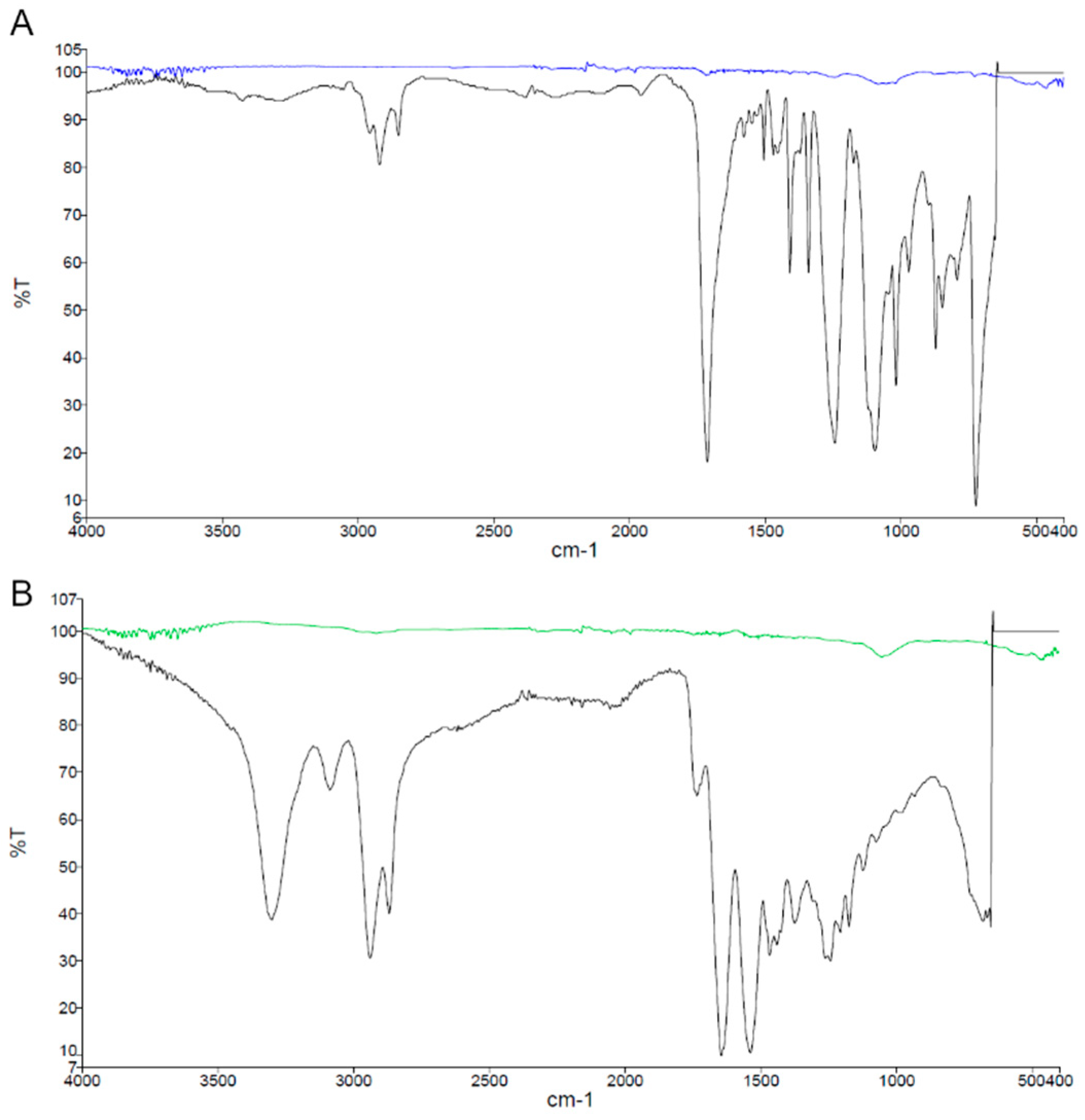The Occurrence and Characteristics of Microplastics in Seawater Surface and Sea Cucumber (Holothuria atra and Holothuria edulis) at Similan and Surin Islands (Andaman Sea), Thailand
Highlights
- We found that black fiber is one of the major microplastics found in surface seawater and sea cucumbers, Holothuria atra, and Holothuria edulis.
- PET and polyester are the most prevalent polymers, which can be identified in surface seawater. Cotton blends are the dominant polymer found in sea cucumbers.
- Our findings implied that microplastics found in surface seawater could potentially come from aquaculture equipment, waterborne transport, and plastic packaging, while microplastics in sea cucumbers probably originated from household sewage discharge.
Abstract
1. Introduction
2. Materials and Methods
2.1. Study Area and Sampling Methods
2.2. Laboratory and Data Analysis
3. Results
3.1. Microplastic Particles in Seawater
3.2. Microplastic Particles in Sea Cucumbers
4. Discussion
4.1. Microplastic Particles in Surface Seawater
4.2. Microplastic Particles in Sea Cucumbers
5. Conclusions
Author Contributions
Funding
Institutional Review Board Statement
Informed Consent Statement
Data Availability Statement
Acknowledgments
Conflicts of Interest
References
- Crini, G.; Lichtfouse, E. Advantages; disadvantages of techniques used for wastewater treatment. Environ. Chem. Lett. 2019, 17, 145–155. [Google Scholar] [CrossRef]
- Duis, K.; Coors, A. Microplastics in the aquatic; terrestrial environment: Sources (with a specific focus on personal care products), fate; effects. Environ. Sci. Eur. 2016, 28, 1–25. [Google Scholar] [CrossRef] [PubMed]
- Avio, C.G.; Gorbi, S.; Regoli, F. Plastics; microplastics in the oceans: From emerging pollutants to emerged threat. Mar Environ Res. 2017, 128, 2–11. [Google Scholar] [CrossRef]
- Andrady, A.L. Common Plastics Materials. In Plastics and the Environment; John Wiley & Sons, Ltd.: Hoboken, NJ, USA, 2003; pp. 77–121. [Google Scholar] [CrossRef]
- Law, K.L.; Thompson, R.C. Microplastics in the seas. Science 2014, 345, 144–145. [Google Scholar] [CrossRef]
- Barnes, D.K.; Galgani, F.; Thompson, R.C.; Barlaz, M. Accumulation; fragmentation of plastic debris in global environments. Philos. Trans. R. Soc. B Biol. Sci. 2009, 364, 1985–1998. [Google Scholar] [CrossRef] [PubMed]
- Frias, J.P.G.L.; Nash, R. Microplastics: Finding a consensus on the definition. Mar. Pollut. Bull. 2019, 138, 145–147. [Google Scholar] [CrossRef]
- Song, J.; Wang, C.; Li, G. Defining Primary and Secondary Microplastics: A Connotation Analysis. ACS EST Water 2024, 4, 2330–2332. [Google Scholar] [CrossRef]
- Akdogan, Z.; Guven, B. Microplastics in the environment: A critical review of current understanding; identification of future research needs. Environ. Pollut. 2019, 254, 113011. [Google Scholar] [CrossRef]
- Cole, M.; Lindeque, P.; Halsband, C.; Galloway, T.S. Microplastics as contaminants in the marine environment: A review. Mar. Pollut. Bull. 2011, 62, 2588–2597. [Google Scholar] [CrossRef] [PubMed]
- Klein, S.; Worch, E.; Knepper, T.P. Occurrence; spatial distribution of microplastics in river shore sediments of the rhine-main area in Germany. Environ. Sci. Technol. 2015, 49, 6070–6076. [Google Scholar] [CrossRef]
- Yang, J.; Monnot, M.; Sun, Y.; Asia, L.; Wong-Wah-Chung, P.; Doumenq, P.; Moulin, P. Microplastics in different water samples (seawater, freshwater,; wastewater): Removal efficiency of membrane treatment processes. Water Res. 2023, 232, 119673. [Google Scholar] [CrossRef]
- Öztekin, A.; Üstün, F.; Bat, L.; Tabak, A. Microplastic Contamination of the Seawater in the Hamsilos Bay of the Southern Black Sea. Water Air Soil Pollut 2024, 235, 325. [Google Scholar] [CrossRef]
- Fischer, V.; Elsner, N.O.; Brenke, N.; Schwabe, E.; Brandt, A. Plastic pollution of the Kuril–Kamchatka Trench area (NW pacific). Deep. Sea Res. Part II Top. Stud. Oceanogr. 2015, 111, 399–405. [Google Scholar] [CrossRef]
- Woodall, L.C.; Sanchez-Vidal, A.; Canals, M.; Paterson, G.L.; Coppock, R.; Sleight, V.; Calafat, A.; Rogers, A.D.; Narayanaswamy, B.E.; Thompson, R.C. The deep sea is a major sink for microplastic debris. R. Soc. Open Sci. 2014, 1, 140317. [Google Scholar] [CrossRef] [PubMed]
- Mohsen, M.; Lin, C.; Liu, S.; Yang, H. Existence of microplastics in the edible part of the sea cucumber Apostichopus japonicus. Chemosphere 2022, 287, 132062. [Google Scholar] [CrossRef]
- Dissanayake, D.C.T.; Stefansson, G. Habitat preference of sea cucumbers: Holothuria atra; Holothuria edulis in the coastal waters of Sri Lanka. J. Mar. Biol. Assoc. UK 2012, 92, 581–590. [Google Scholar] [CrossRef]
- Purcell, S.W.; Mercier, A.; Conand, C.; Hamel, J.F.; Toral-Granda, M.V.; Lovatelli, A.; Uthicke, S. Sea cucumber fisheries: Global analysis of stocks, management measures; drivers of overfishing. Fish; Fisheries 2013, 14, 34–59. [Google Scholar] [CrossRef]
- Ventura, D.; Rakaj, A.; Lasinio, G.J.; Sangiovanni, G.M.; Poggio, D.; Mastrantonio, G.; Pollice, A.; Grasso, G.; Casoli, E.; Mancini, G.; et al. Detecting habitat preferences; monitoring population dynamics of sea cucumbers in coastal ecosystems through underwater photogrammetry. J. Environ. Manag. 2025, 377, 124589. [Google Scholar] [CrossRef] [PubMed]
- Parra-Luna, M.; Martín-Pozo, L.; Hidalgo, F.; Zafra-Gómez, A. Common sea urchin (Paracentrotus lividus); sea cucumber of the genus Holothuria as bioindicators of pollution in the study of chemical contaminants in aquatic media. A revision. Ecol. Indic. 2020, 113, 106185. [Google Scholar] [CrossRef]
- Marrugo-Negrete, J.; Pinedo-Hernández, J.; Marrugo-Madrid, S.; Navarro-Frómeta, E.; Sea, S.D. Cucumber as Bioindicator of Trace Metal Pollution in Coastal Sediments. Biol. Trace Elem. Res. 2021, 199, 2022–2030. [Google Scholar] [CrossRef]
- Umasangaji, H.; Ramili, Y. The Occurrence of Microplastics in the Gastrointestinal Tract of Sea Cucumbers on the Conservation area of Mare Island, North Maluku, Indonesia, 2025; Volume 15, p. 2022. Available online: http://www.bioflux.com.ro/aacl (accessed on 27 August 2025).
- Purcell, S.W.; Conand, C.; Uthicke, S.; Byrne, M. Ecological Roles Of Exploited Sea Cucumbers. Oceanogr. Mar. Biol. Annu. Rev. 2016, 54, 367–386. [Google Scholar] [CrossRef]
- Li, Y.; Tao, L.; Wang, Q.; Wang, F.; Li, G.; Song, M. Potential Health Impact of Microplastics: A Review of Environmental Distribution, Human Exposure; Toxic Effects. Environ. Health 2023, 1, 249–257. [Google Scholar] [CrossRef]
- Lee, Y.; Cho, J.; Sohn, J.; Kim, C. Health Effects of Microplastic Exposures: Current Issues; Perspectives in South Korea. Yonsei Med. J. 2023, 64, 301. [Google Scholar] [CrossRef]
- Mutuku, J.; Yanotti, M.; Tocock, M.; Hatton, D. MacDonald The Abundance of Microplastics in the World’s Oceans: A Systematic Review. Oceans 2024, 5, 398–428. [Google Scholar] [CrossRef]
- Masura, J.; Baker, J.; Foster, G.D.; Arthur, C.; Herring, C. Laboratory Methods for the Analysis of Micro-Plastics in the Marine Environment: Recommendations for Quantifying Synthetic Particles in Waters; Sediments. Available online: https://repository.library.noaa.gov/view/noaa/10296 (accessed on 5 August 2025).
- R Core Team. R: A Language; Environment for Statistical Computing. R Foundation for Statistical Computing, Vienna. Open J. Stat. 2023, 13, 2. Available online: https://www.scirp.org/reference/referencespapers?referenceid=3456808 (accessed on 29 April 2025).
- Buckingham, J.; Manno, C.; Waluda, C.; Waller, C. A record of microplastic in the marine nearshore waters of South Georgia. Environ. Pollut. 2022, 306, 119379. [Google Scholar] [CrossRef]
- Lei, X.; Cheng, H.; Luo, Y.; Zhang, Y.; Jiang, L.; Sun, Y.; Zhou, G.; Huang, H. Abundance and Characteristics of Microplastics in Seawater and Corals From Reef Region of Sanya Bay, China. Front. Mar. Sci. 2021, 8, 728745. [Google Scholar] [CrossRef]
- Xia, B.; Sui, Q.; Sun, X.; Zhu, L.; Wang, R.; Cai, M.; Chen, B.; Qu, K. Microplastic pollution in surface seawater of Sanggou Bay, China: Occurrence, source and inventory. Mar. Pollut. Bull. 2021, 162, 111899. [Google Scholar] [CrossRef]
- Qu, J.; Wu, P.; Pan, G.; Li, J.; Jin, H. Microplastics in Seawater, Sediment, and Organisms from Hangzhou Bay. Mar. Pollut. Bull. 2022, 181, 113940. [Google Scholar] [CrossRef]
- Wei, Y.; Ma, W.; Xu, Q.; Sun, C.; Wang, X.; Gao, F. Microplastic Distribution; Influence Factor Analysis of Seawater; Surface Sedi-ments in a Typical Bay With Diverse Functional Areas: A Case Study in Xincun Lagoon, China. Front. Environ. Sci. 2022, 10, 829942. [Google Scholar] [CrossRef]
- Nhon, N.T.T.; Nguyen, N.T.; Hai, H.T.N.; Minh, T.H.; Hien, T.T. Microplastic pollution in coastal surface seawater of Southern Vietnam. Environ. Monit. Assess. 2024, 196, 1077. [Google Scholar] [CrossRef]
- Vibhatabandhu, S. Srithongouthai Abundance; Characteristics of Microplastics Contaminating The Surface Water of The Inner Gulf of Thailand. Priprint 2021. [Google Scholar] [CrossRef]
- Akkajit, P.; Yuankerd, S.; Sukkuea, A. Exploring Microplastics in Seawater and Zooplankton on the Eastern Coast of Thailand: A Case Study in Phuket Province. Appl. Environ. Res. 2024, 46, 1–10. [Google Scholar] [CrossRef]
- Ruangpanupan, N.; Ussawarujikulchai, A.; Prapagdee, B.; Chavanich, S. Microplastics in the surface seawater of Bandon Bay, Gulf of Thailand. Mar. Pollut. Bull. 2022, 179, 113664. [Google Scholar] [CrossRef]
- Forero-López, A.; Rimondino, G.; Truchet, D.; Colombo, C.; Buzzi, N.; Malanca, F.; Spetter, C.; Severini, F. Occurrence, distribution, and characterization of suspended microplastics in a highly impacted estuarine wetland in Argentina. Sci. Total Environ. 2021, 785, 147141. [Google Scholar] [CrossRef]
- Belioka, M.-P.; Achilias, D.S. Microplastic Pollution and Monitoring in Seawater and Harbor Environments: A Meta-Analysis and Review. Sustainability 2023, 15, 9079. [Google Scholar] [CrossRef]
- Lusher, A.L.; Tirelli, V.; O’cOnnor, I.; Officer, R. Microplastics in Arctic polar waters: The first reported values of particles in surface and sub-surface samples. Sci. Rep. 2015, 5, 14947. [Google Scholar] [CrossRef]
- Acharya, S.; Rumi, S.S.; Hu, Y.; Abidi, N. Microfibers from synthetic textiles as a major source of microplastics in the environment: A review. Text. Res. J. 2021, 91, 2136–2156. [Google Scholar] [CrossRef]
- Hernandez, E.; Nowack, B.; Mitrano, D.M. Polyester Textiles as a Source of Microplastics from Households: A Mechanistic Study to Understand Microfiber Release During Washing. Environ. Sci. Technol. 2017, 51, 7036–7046. [Google Scholar] [CrossRef]
- Bergmann, M.; Tekman, M.B.; Gutow, L. Marine litter: Sea change for plastic pollution. Nature 2017, 544, 297. [Google Scholar] [CrossRef]
- Akdogan, Z.; Guven, B. Modeling the settling and resuspension of microplastics in rivers: Effect of particle properties and flow conditions. Water Res. 2024, 264, 122181. [Google Scholar] [CrossRef] [PubMed]
- Idris, F.; Febrianto, T.; Hidayati, J.R.; Rajib; Nugraha, A.H. Microplastic abundance in sea cucumber at seagrass ecosystem of Bintan Island and surrounding area, Indonesia. In IOP Conference Series: Earth and Environmental Science, Bogor, Indonesia, 11–12 August 2021; IPO Publishing: Bristol, UK, 2021; Volume 967, p. 012009. [Google Scholar]
- Riani, E.; Cordova, M.R. Microplastic ingestion by the sandfish Holothuria scabra in Lampung and Sumbawa, Indonesia. Mar. Pollut. Bull. 2022, 175, 113134. [Google Scholar] [CrossRef] [PubMed]
- Phaksopa, J.; Sukhsangchan, R.; Keawsang, R.; Tanapivattanakul, K.; Thamrongnawasawat, T.; Worachananant, S.; Sreesamran, P. Presence and Characterization of Microplastics in Coastal Fish around the Eastern Coast of Thailand. Sustainability 2021, 13, 13110. [Google Scholar] [CrossRef]
- Amin, B.; Rukim, M.; Nurrachmi, I. Presence of Microplastics in Sea Cucumber Paracaudina sp from Karimun Island, Kepulauan Riau, Indonesia. In IOP Conference Series: Earth and Environmental Science, Pekanbaru, Indonesia, 15–16 September 2021; IPO Publishing: Bristol, UK, 2021; Volume 934, p. 012053. [Google Scholar]
- Yeemin, T.; Sutthacheep, M.; Plangngan; Klomjit, A.; Aunkhongthong, W.; Jungrak, L. Microplastics in marine sediment at the coral reef hotspots of Mu Ko Similan National Park, Phang Nga Province. Ramkhamhaeng Int. J. Sci. Technol. 2018, 1, 22–29. Available online: https://ph02.tci-thaijo.org/index.php/RIST/article/view/245873 (accessed on 31 July 2025).
- Ounjai, K.; Boontanon, S.K.; Piyaviriyakul, P.; Tanaka, S.; Fujii, S. Assessment of microplastic contamination in the urban lower Chao Phraya River of Bangkok city, Thailand. J. Water Heal. 2022, 20, 1243–1254. [Google Scholar] [CrossRef]
- Pradit, S.; Noppradit, P.; Sengloyluan, K.; Suwanno, P.; Tanrattanakul, V.; Sornplang, K.; Nuthammachot, N.; Jitkaew, P.; Nitiratsuwan, T. Occurrence of Microplastics in River Water in Southern Thailand. J. Mar. Sci. Eng. 2023, 11, 90. [Google Scholar] [CrossRef]





| Location | Study Site for Seawater Samples | Coordinates | Species of Sea Cucumber | Number of Sea Cucumber Samples |
|---|---|---|---|---|
| Similan Island | Ao Guangchang | 8°40′14.0″ N 97°38′57.0″ E | Holothuria atra | 17 |
| Island9 | 8°39′23.2″ N 97°39′09.6″ E | |||
| Surin Island | Stock | 9°26′48.92″ N 97°54′20.95″ E | Holothuria edulis | 50 |
| Torinla | 9°22′25.60″ N 97°52′28.95″ E |
| Location | Species of Sea Cucumber | Average Abundance (Pieces/Individual) | SD | F Value | p-Value |
|---|---|---|---|---|---|
| Similan Island | Holothuria atra | 24.1 | 14.05 | 44.22 | <0.001 |
| Surin Island | Holothuria edulis | 6.73 | 5.35 |
| Authors and Year | Abundance (Items/m3) (Mean ± SD) | Location |
|---|---|---|
| Buckingham et al., 2022 [29] | 1.75 ± 5.17 | South Georgia |
| Lei et al., 2021 [30] | 18.37 ± 2.60 | Sanya Bay, China |
| Xia et al., 2021 [31] | 20.06 ± 4.73 | Sanggou Bay, China |
| Qu et al., 2022 [32] | 0.77–9.6 | Hangzhou Bay, China |
| Wei et al., 2022 [33] | 60.9 ± 21.5 | Xincun Lagoon, China |
| Nhon et al., 2024 [34] | 0.074 ± 0.109 | Can Gio, Vietnam |
| Nhon et al., 2024 [34] | 0.56 ± 0.35 | Tien Giang, Vietnam |
| Vibhatabandhu et al., 2021 [35] | 9.97 ± 18.55 | Inner Gulf of Thailand |
| Akkajit et al., 2024 [36] | 52.6 ± 21.4 | Phuket, Thailand |
| Ruangpanupan et al., 2022 [37] | 0.04 ± 0.33 | Bandon Bay, Thailand |
| This study | 1.93 ± 1.42 | Similan Island, Thailand |
| This study | 1.11 ± 0.75 | Surin Island, Thailand |
Disclaimer/Publisher’s Note: The statements, opinions and data contained in all publications are solely those of the individual author(s) and contributor(s) and not of MDPI and/or the editor(s). MDPI and/or the editor(s) disclaim responsibility for any injury to people or property resulting from any ideas, methods, instructions or products referred to in the content. |
© 2025 by the authors. Licensee MDPI, Basel, Switzerland. This article is an open access article distributed under the terms and conditions of the Creative Commons Attribution (CC BY) license (https://creativecommons.org/licenses/by/4.0/).
Share and Cite
Wonglersak, R.; Jeensin, S.; Sumitrakij, R.; Mucharin, A. The Occurrence and Characteristics of Microplastics in Seawater Surface and Sea Cucumber (Holothuria atra and Holothuria edulis) at Similan and Surin Islands (Andaman Sea), Thailand. Toxics 2025, 13, 853. https://doi.org/10.3390/toxics13100853
Wonglersak R, Jeensin S, Sumitrakij R, Mucharin A. The Occurrence and Characteristics of Microplastics in Seawater Surface and Sea Cucumber (Holothuria atra and Holothuria edulis) at Similan and Surin Islands (Andaman Sea), Thailand. Toxics. 2025; 13(10):853. https://doi.org/10.3390/toxics13100853
Chicago/Turabian StyleWonglersak, Rungtip, Sireepus Jeensin, Ratchaneewarn Sumitrakij, and Arom Mucharin. 2025. "The Occurrence and Characteristics of Microplastics in Seawater Surface and Sea Cucumber (Holothuria atra and Holothuria edulis) at Similan and Surin Islands (Andaman Sea), Thailand" Toxics 13, no. 10: 853. https://doi.org/10.3390/toxics13100853
APA StyleWonglersak, R., Jeensin, S., Sumitrakij, R., & Mucharin, A. (2025). The Occurrence and Characteristics of Microplastics in Seawater Surface and Sea Cucumber (Holothuria atra and Holothuria edulis) at Similan and Surin Islands (Andaman Sea), Thailand. Toxics, 13(10), 853. https://doi.org/10.3390/toxics13100853






